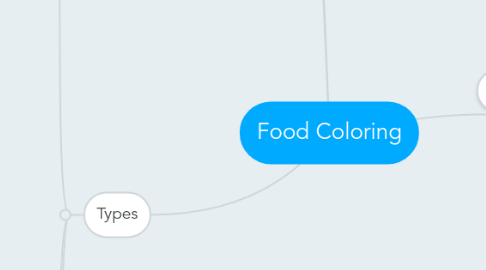
1. Types
1.1. Natural
1.1.1. Colors derived from natural sources like vegetables, minerals and animals.
1.1.2. Examples
1.1.2.1. 1. carotenoids: yellow to red (carrots) 2. anthocyanins: red, purple, blue(red cabbage,beet) 3. caramel color: light yellow to dark brown(sugar, corn syrup) 4. tumeric: yellow (dried, ground rhizomes of herbs- Curcuma longa) 5. annatto: yellow to reddish orange (seeds) 6. carmine/cochineal: pink, red, magenta (insects) 7. Lutein: Bright yellow/ golden shades(grass, alfalfa, Aztec marigold) 8. Lycopene: Red (Red tomato) 9. sodium copper chlorophyllin: bright green (green plant parts) 10. astaxanthin 11. paprika: deep red (pepper pods, Capsicum annum) 12. paprika oleoresin: orange-red (extract from C. annum) 13. riboflavin 14. saffron 15. titanium dioxide: white(A minral, ilmenite)
1.1.2.1.1. Caramel color
1.1.3. Advantages
1.1.3.1. Most natural colos are oil soluble. This makes them well-suited for tinting high-fat, low-moisture foods without the special considerations of using an F.D&C lake.
1.1.3.2. Natural color can provide transparent color to liquid, oil-based products. - Annatto, in particular , is commonly used in cheddar cheese because it binds to milk protein.
1.1.3.3. Some natural pigments have been shown to have nutraceutical value. - carotenoids and anthocyanins are pigments currently recognized for their value as antioxidants.
1.1.4. Disadvantages
1.1.4.1. Natural colors are less stable as they are more sensitive to light and heat exposure. It's stability will be affected by changes in pH. Changes in pH can shift the resulting natural color to a different hue.
1.1.4.1.1. Methods to improve stability
1.1.4.2. Natural color are not available in blue or green.
1.1.4.3. It takes much higher levels as much as 10-100 times of a natural color depends on the applications to obtain the same tint as can be obtained otherwise
1.1.4.4. Objectionable off flavors and off odors. Natural color concentrates are typically 4 to 10 times more concentrated than the native juice.
1.1.4.5. Using a natural color costs more money as it is extracted from expensive natural materials with expensive means.
1.2. Synthetic
1.2.1. Certified by The Food & Drug Administration in United States
1.2.2. Benificials: 1. More economical( smaller quantity is required to give the same color intensity. 2. Easily produce uniform. 3. Provides intense colors. 4. Stands up to heat, light, pH and other factors. 5. It does not add off-flavors.
1.2.3. Man made water soluble dyes: Have been assigned with FD&C numbers. -FD&C Blue No. 1: Brilliant Blue -FD&C Blue No. 2: Indigotine (royal blue) -FD&C Green No. 3: Fast Green FCF (sea green) -Orange B -Citrus Red No. 2 -FD&C Red No. 3: Erythrosine (cherry red) -FD&C Red No. 40: Allura Red AC (orange-red) -FD&C Yellow No.5: Tartrazine (lemon yellow) -FD&C Yellow No.6: Sunset Yellow (orange)
1.3. Lakes
1.3.1. Water soluble FD&C dyes that are combined with an insoluble material/substrate.
1.3.1.1. For FD&C colors, the base is aluminium hydroxide, with aluminium cation serving as the precipitant, such that the color adsorbs onto the surface of aluminium hydroxide.
1.3.2. Impart color by dispersing into a medium rather than via adsorption.
1.3.3. Only six FD&C colors are approved by FDA to make their lakes version: 1. FD&C Yellow No.5 2. FD&C Yellow No.6 3. FD&C Red No. 40 4. FD&C Blue No. 1 5. FD&C Blue No. 2 6. FD&C Green No.3 * One natural color, carmine also has an approved lake version.
1.3.4. Factors affect usage level - typical usage rates range from 0.05% to 0.30%
1.3.4.1. Desired shade and intensity
1.3.4.2. Product composition: - moisture -solids - fat content
1.3.4.3. Opacity of products
1.3.5. Its particle size affect the finished product color. - smaller particles dispersed thoroughly in the matrix results in a more intense color due to increased surface area.
1.3.6. Stable at pH between 4.0-8.0 - outside the range, lakes' substrates typically break down, releasing the dye and causing color migration.
1.3.7. Applications
1.3.7.1. -Useful in products containing fats and oils - chocolates, compound coatings, icings and cookie fillings.
1.3.7.2. Chewing gum
1.3.7.3. Colored noodle products
1.3.8. Advantages
1.3.8.1. Useful in dry mixes like snack seasonings that have insufficient moisture to dissolve water-soluble colors.
1.3.8.2. Avoiding color migration as lakes impart their pigments to foods, not by solubilization, but by evenly dispersing colored particles throughout the products.
1.3.8.3. Imparts increased opacity to confections.
2. Natural identical colors
2.1. Produced by chemical synthesis and are considered chemically and functionally identical to the same colorant found in natural.
2.1.1. Examples
2.1.1.1. 1. Beta carotene: Yellow to red (Algae) 2. Beta-apo-8'-carotenal
3. Combining colors
3.1. Produced by combining artificial and natural colors.
3.1.1. Examples
3.1.1.1. Artificial blues are being combined with cabbage purples or carmine to produce bright purple shades.
3.1.1.2. Carmine with yellowish caramel can produce a green color.
3.1.1.3. Turmeric and artificial blue can make more like neon green.
